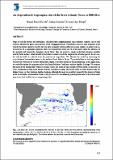Por favor, use este identificador para citar o enlazar a este item:
http://hdl.handle.net/10261/170548COMPARTIR / EXPORTAR:
 SHARE
BASE SHARE
BASE
|
|
| Visualizar otros formatos: MARC | Dublin Core | RDF | ORE | MODS | METS | DIDL | DATACITE | |

| Título: | An Argo-inferred Lagrangian view of the South Atlantic Ocean at 1000 dbar |
Autor: | Rosell Fieschi, Miquel CSIC ORCID; Gourrion, Jérôme CSIC; Pelegrí, Josep Lluís CSIC ORCID | Fecha de publicación: | 20-jul-2016 | Editor: | Universidad de Alicante | Citación: | Libro de Resúmenes. IV Encuentro Oceanografía Física Española: 119 (2016) | Resumen: | Maps of velocity vectors and streamlines, calculated after integration from some reference contour, can be very useful to illustrate the gross characteristics of the changing velocities. Nevertheless, they are only snapshots of the velocity field that cannot be used to directly infer exchange between different oceanic regions. In order to do so, we must use of a Lagrangian approach, where we actually track water parcels as they move under the influence of the spatially and temporally changing velocity fields. Here we present a simple model that integrates monthly velocity fields in time, either forward or backward, in order to track the origin or fate of water parcels. In our case, the velocity fields are inferred from the positions of Argo floats. We illustrate the model by examining the recirculation of intermediate waters in the southern South Atlantic Ocean. The model allows us tracking whether and how the water parcels at these intermediate depths recirculate zonally or drift meridionally. In this application, we carefully explore the important role of the Brazil-Malvinas Confluence and the Agulhas Leakage. We estimate that most of the intermediate waters recirculate across the ocean in time periods between about 15 and 30 years, eventually meeting at the Brazil-Malvinas Confluence region. Our results show no water transfer from the Indian Ocean, i.e. they show no Agulhas Leakage, although this may be an artefact caused by the absence of rings in the mean fields. A remarkable feature is the presence of a meridionally pulsating behaviour in the transoceanic trajectories, best visible in an accompanying video | Descripción: | IV Encuentro Oceanografía Física Española, celebrado del 20 al 22 de julio de 2016 en Alicante,España.-- 1 page, 1 figure | Versión del editor: | http://rua.ua.es/dspace/handle/10045/59211 | URI: | http://hdl.handle.net/10261/170548 | Identificadores: | isbn: 978-84-16724-17-8 |
| Aparece en las colecciones: | (ICM) Comunicaciones congresos |
Ficheros en este ítem:
| Fichero | Descripción | Tamaño | Formato | |
|---|---|---|---|---|
| Rosell_et_al_2016.pdf | 185,41 kB | Adobe PDF |  Visualizar/Abrir |
CORE Recommender
Page view(s)
186
checked on 18-abr-2024
Download(s)
70
checked on 18-abr-2024
Google ScholarTM
Check
Este item está licenciado bajo una Licencia Creative Commons

